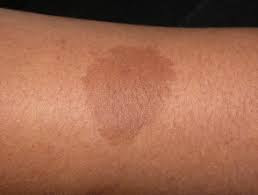Do they pose a health risk?
Slate gray nevi are harmless, but they can occasionally occur alongside some are a rare disease that affects a person's metabolism such as:
- Hurler's disease
- Hunter's syndrome
- Niemann-Pick disease
- Mucolipidosis
- Mannosidosis
The link may be more likely in those with marks that are large and widespread or on areas outside the back and buttock regions. Slay gray nevi may also occur with other birthmarks linked to vascular features or pigmentation, such as cafe'-au-lait macules. |
| Cafe'-au-lait macules |
Treatment
- Soon after delivery, a doctor will examine any marks that the newborn may have and document them in the baby's medical record.
- Parents, caregivers, and healthcare professionals can check the spots at regular intervals to determine whether they are going away on their own as the child grows. Most slate gray nevi disappear in time.
Is the treatment necessary?
People with slate gray nevi do not need any special care unless the marks occur alongside another condition. They are not painful and do not pose a health problem. According to the American Society for Dermatological Surgery, they require no treatment.
Laser removal
- If slate gray nevi persists into adulthood, and a person finds them bothersome, removal procedures may be an option.
- In a small study in Japan, professionals used a service called an alexandrite laser to treat slate gray nevi in 16 people. Overall, they concluded that the treatment was successful. However, two participants left the study as they were not happy with the results, and two experienced hyperpigmentation after the treatment.
- The result of another Japan suggests that treatment might be more successful before the age of 20 years. The authors also concluded that adjusting the timing of sessions to optimize the intervals might lower the risk of skin darkening as a side effect.



Comments
Post a Comment